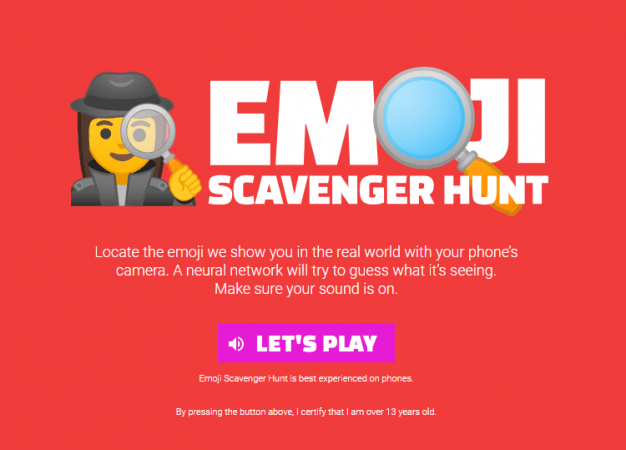There are innumerable mobile games out there with many offering life-like graphics and a superb gameplay, and there are also games like Pokemon Go that allow you to use your phone's camera to track and catch imaginary creatures called Pokemon. These kinds of games use augmented reality (AR) to visualize the character in a real-life scenario. And while we are seeing a lot of innovations happening in the field, Google, the world's biggest search engine company, has launched a new game of its own called "Emoji Scavenger Hunt" using its advanced machine learning tools.

Launched under its new Artificial Intelligence (AI) experiment initiative, the game shows how the Alphabet-owned company's machine learning tools can be used to make fun mobile games which go beyond the virtual world. Just like Pokemon Go, Google's Emoji Scavenger Hunt makes use of your phone's camera, but it does not create AR objects or creatures, rather it asks you to locate and point the camera at real world objects that match an emoji. What makes it fun though is that it has a time limit and with each successful find, the time limit increases.
The game is not only engaging and entertaining but is also fun and interactive. However, Google hasn't a dedicated Emoji Scavenger Hunt game/app listed on Play Store yet. To play the game, you will need to visit emojiscavnegerhunt.withgoogle.com on your Android smartphone or iPhone browser. In case you were wondering, the game is only available on mobile phones and cannot be played on PCs.
Once you open the website, you will be asked a permission to access your phone's camera. Grant the permission and you're set. The first level or scavenger hunt is very basic, for example, it will ask you to find and point the camera at things like your palm, a computer, or a television set – objects which can be found easily in your vicinity. The difficulty increases as you go on clearing the levels. The website also allows you to share your scores on social media platforms like Facebook and Twitter.
"Locate the emoji we show you in the real world with your phone's camera. A neural network will try and guess what it's seeing. Make sure your sound is on," reads the game's description.
The game uses Google's advanced machine learning algorithms to guess what the object is and matches it with the Emoji displayed on the screen.
Google has made it clear that it does not store any of the user's images taken while playing the game on its servers.
"All the interactions are happening locally on your device," added Google.
How does Google's AI-based Emoji Scavenger Hunt game work?
Google's Emoji Scavenger Hunt is based on a complex AI platform called Tensorflow.js, a browser-based JavaScript library for training and deploying machine learning models. It allows developers to use highly advanced machine learning tools in web browsers. If you are a developer or want to know more about how to make similar AI-based games or apps take a look here. You can also check out Google's other AI experiments here.
Meanwhile, Google is gearing up for its annual I/O Developer Conference which is slated to begin May 8 and concludes May 10 at Shoreline Amphitheatre in Google's hometown Mountain View, California.
According to a report by The Verge, Google could make a big Ai-related announcement at the event. The Android-maker is also expected to update its AI camera app, Google Lens, and also update its specialized AI chips known as TPUs.
In April this year, Google gave is a glimpse of how far natural language processing technology has come. For the unaware, the technology deals with machine reading comprehension and is used in voice-based e-books and read-outs.
Google Research has also rolled out Semantic Experiences, which are basically websites with interesting activities that demonstrate AI's ability to understand how we speak.
The Semantic Experiences has two interactive experiences for the users to enjoy and the third one is for developers to help create their own experience.
The first experience is called "Talk to Books" where the user can explore new ways of interacting with books, and the second "Semantris" allows the user to play word association games powered by the semantic search.
Google has reportedly trained its AI by feeding it a "billion conversation-like pairs of sentences," so it can learn and identify what natural human conversations look like and respond accordingly.















